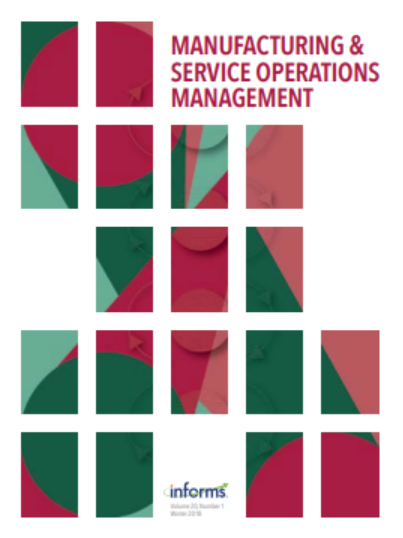电子商务平台中物流绩效、评级及其对客户购买行为和销售的影响
IF 4.8
3区 管理学
Q1 MANAGEMENT
M&som-Manufacturing & Service Operations Management
Pub Date : 2023-05-01
DOI:10.1287/msom.2021.1045
引用次数: 12
摘要
问题定义:我们研究物流绩效指标(如交货时间和客户要求的交货速度)对物流服务评级和第三方卖家在电子商务平台上的销售的影响。学术/实践相关性:虽然像亚马逊这样的电子商务零售商最近在他们的物流网络上投入了大量资金,以便为客户提供更快的送货服务,但很少有学术文献对方便快捷的送货会推动销售这一前提进行测试和量化。在本文中,我们通过分析一种通过物流评级将交付绩效与销售联系起来的机制,提供了这种关系在实践中是否成立的经验证据。之前关于电子商务平台在线评级的学术工作主要是分析客户对产品功能性能的反应和存在的偏见。我们的研究通过分析物流服务绩效、物流评级及其对客户购买概率和销售的影响,从服务质量的角度考察客户体验,为这一文献流做出了贡献。研究方法:使用天猫平台和菜鸟网络(阿里巴巴的物流部门)上超过1500万客户订单的广泛数据集,我们使用Heckman有序回归模型来解释客户对物流绩效评级的变化以及客户发布物流评级的可能性。接下来,我们开发了一个通用的客户选择模型,该模型将客户购买的可能性与先前客户提供的物流评级联系起来。我们实现了选择模型的两步估计,以量化物流评级对客户购买概率和第三方卖家销售的影响。结果:我们惊讶地发现,即使客户没有交付速度的承诺,可能会张贴较低的物流评级,交付时间超过两天。虽然这些客户没有得到明确的交货期限承诺,但他们似乎有一个两天的心理门槛,并期望在这段时间内交货。同样,我们发现优先客户(那些有两天和一天承诺速度的客户)在交付时间超过预期交付日期时提供的物流评级较低。我们估计,将该平台上所有三天交货订单(占总订单的35%)的交货时间减少到两天,该平台上第三方卖家的平均日销售额将提高13.3%。配送时间对销售额的影响对于那些三天送达订单比例较高、单笔支出较高的卖家来说更为显著。管理启示:我们的研究强调,衡量服务质量的配送绩效和物流评级是电子商务平台上客户购买决策的重要驱动因素。此外,通过量化交货时间绩效对销售的影响,我们的研究还为在线零售商提供了一个框架,以评估由于物流绩效的改善而增加的销售是否可以抵消更快交货所需的额外基础设施成本的增加。我们的研究见解与旨在提高长期在线客户流量和销售的第三方卖家和电子商务平台经理相关。历史:本文已被接受为2018年MSOM数据驱动研究挑战赛的一部分。补充材料:在线附录可在https://doi.org/10.1287/msom.2021.1045上获得。本文章由计算机程序翻译,如有差异,请以英文原文为准。
Logistics Performance, Ratings, and Its Impact on Customer Purchasing Behavior and Sales in E-Commerce Platforms
Problem definition: We examine the impact of logistics performance metrics such as delivery time and customer’s requested delivery speed on logistics service ratings and third-party sellers’ sales on an e-commerce platform. Academic/practical relevance: Although e-commerce retailers like Amazon have recently invested heavily in their logistics networks to provide faster delivery to customers, there is scant academic literature that tests and quantifies the premise that convenient and fast delivery will drive sales. In this paper, we provide empirical evidence on whether this relationship holds in practice by analyzing a mechanism that connects delivery performance to sales through logistics ratings. Prior academic work on online ratings in e-commerce platforms has mostly analyzed customers’ response to product functional performance and biases that exist within. Our study contributes to this stream of literature by examining customer experience from a service quality perspective by analyzing logistics service performance, logistics ratings, and its impact on customer purchase probability and sales. Methodology: Using an extensive data set of more than 15 million customer orders on the Tmall platform and Cainiao network (logistics arm of Alibaba), we use the Heckman ordered regression model to explain the variation in customers’ rating of logistics performance and the likelihood of customers posting a logistics rating. Next, we develop a generic customer choice model that links the customer’s likelihood of making a purchase to the logistics ratings provided by prior customers. We implement a two-step estimation of the choice model to quantify the impact of logistics ratings on customer purchase probability and third-party seller sales. Results: We surprisingly find that even customers with no promise on delivery speed are likely to post lower logistics ratings for delivery times longer than two days. Although these customers are not promised an explicit delivery deadline, they seem to have a mental threshold of two days and expect deliveries to be made within that time. Similarly, we find that priority customers (those with two-day and one-day promise speed) provide lower logistics ratings for delivery times longer than their anticipated delivery date. We estimate that reducing the delivery time of all three-day delivered orders on this platform (which makeup [Formula: see text] 35% of the total orders) to two days would improve the average daily third-party seller sales by 13.3% on this platform. The impact of delivery time performance on sales is more significant for sellers with a higher percentage of three-day delivered orders and a higher spend per order. Managerial implications: Our study emphasizes that delivery performance and logistics ratings, which measure service quality, are essential drivers of the customer purchase decision on e-commerce platforms. Furthermore, by quantifying the impact of delivery time performance on sales, our study also provides a framework for online retailers to assess if the increase in sales because of improved logistics performance can offset the increase in additional infrastructure costs required for faster deliveries. Our study’s insights are relevant to third-party sellers and e-commerce platform managers who aim to improve long-term online customer traffic and sales. History: This paper has been accepted as part of the 2018 MSOM Data Driven Research Challenge. Supplemental Material: The online appendix is available at https://doi.org/10.1287/msom.2021.1045 .
求助全文
通过发布文献求助,成功后即可免费获取论文全文。
去求助
来源期刊

M&som-Manufacturing & Service Operations Management
管理科学-运筹学与管理科学
CiteScore
9.30
自引率
12.70%
发文量
184
审稿时长
12 months
期刊介绍:
M&SOM is the INFORMS journal for operations management. The purpose of the journal is to publish high-impact manuscripts that report relevant research on important problems in operations management (OM). The field of OM is the study of the innovative or traditional processes for the design, procurement, production, delivery, and recovery of goods and services. OM research entails the control, planning, design, and improvement of these processes. This research can be prescriptive, descriptive, or predictive; however, the intent of the research is ultimately to develop some form of enduring knowledge that can lead to more efficient or effective processes for the creation and delivery of goods and services.
M&SOM encourages a variety of methodological approaches to OM research; papers may be theoretical or empirical, analytical or computational, and may be based on a range of established research disciplines. M&SOM encourages contributions in OM across the full spectrum of decision making: strategic, tactical, and operational. Furthermore, the journal supports research that examines pertinent issues at the interfaces between OM and other functional areas.
 求助内容:
求助内容: 应助结果提醒方式:
应助结果提醒方式:


